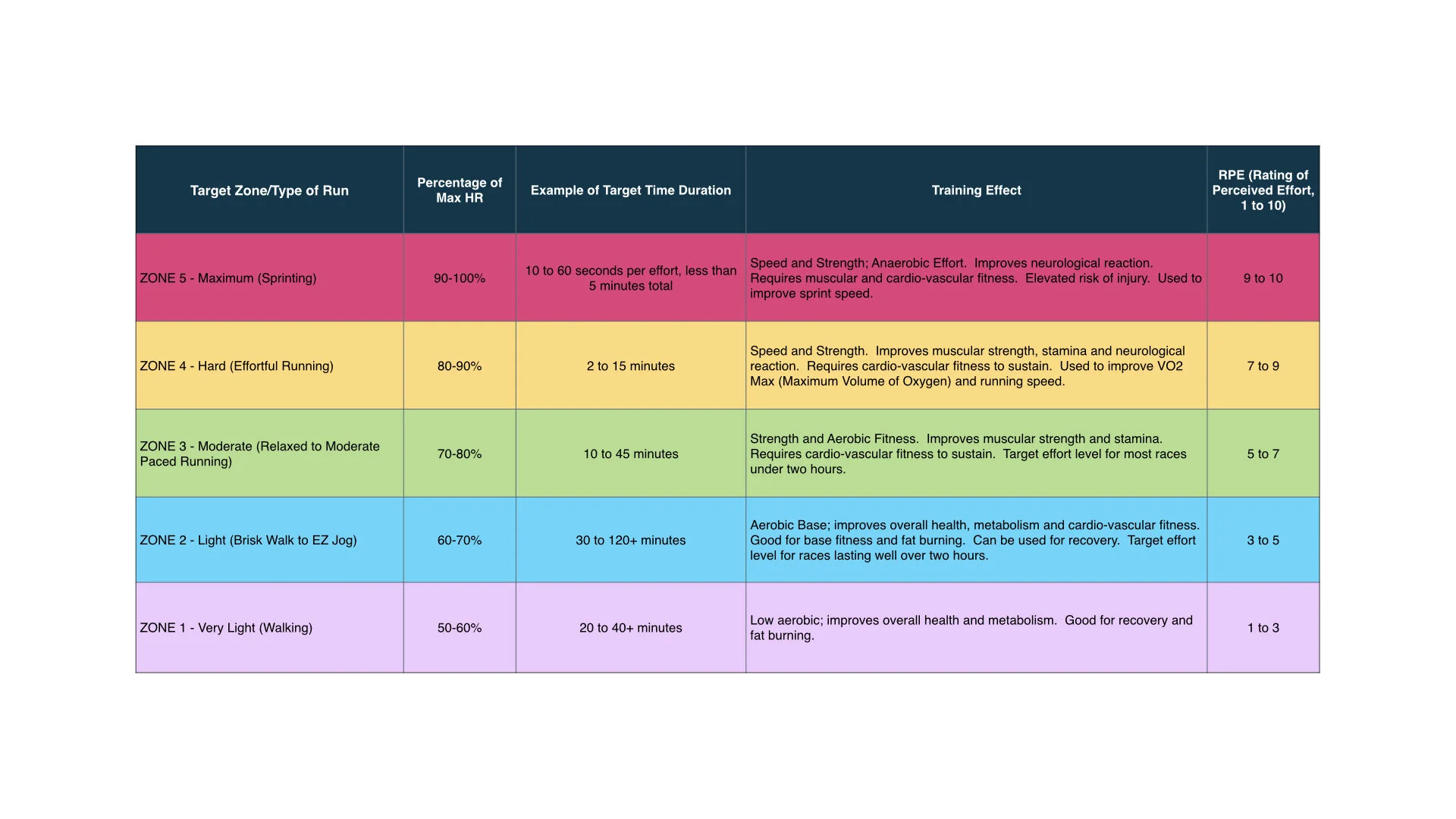About Zones
Endurance events like running are all about moving for a substantial amount of time at a physically sustainable rate. In races, it’s preferable if that rate that is slightly more sustainable for you than the other people in your Age Group. The way one becomes able to motor along at these elevated effort levels for such extended lengths of time is by training one’s body to become acclimated to, and strong enough for, such feats.
While getting stronger is an obvious goal of any exercise, when it comes to endurance sports like running, it’s important to remember that you’re not just training your muscle fibers. You’re training your cardio-vascular system (not just your heart and lungs, but your ability to absorb oxygen efficiently at a cellular level while simultaneously clearing waste products caused by the increased efforts from the muscle cells). You’re training your digestive system, because for runs/races lasting an hour or more, you need to be able to take in nutrition AND effectively absorb it in order to continue to move at a rapid pace for such long periods of time. You’re training your endocrine system, your body’s system of hormones and other chemical messengers, that during prolonged exercise are furiously racing around your body trying to patch things up like a frazzled event planner trying to orchestrate a high society wedding in a demolition zone. And most importantly, you’re training your brain, both physically and mentally. The very thought of running for a duration of anywhere from 30 minutes to several consecutive hours is dismissed out of hand by most people as impossible, or at least as only possible if one is possessed by demonic forces or severe psychiatric disorders (all of which may be true, but that’s a different discussion for another day).
Self-propelling one’s body across vast distances and over prolonged periods of time requires a certain degree of suffering. Such suffering is not for the faint of heart (literally, as well as figuratively. Please check with your doctor and/or cardiologist before starting a new exercise regime). Learning to push yourself through challenging workouts, day in and day out, week after week, is how both your body and your mind becomes accustomed to this unique and decidedly masochistic behavior. As two-time Ironman™ World Champion Chris “Macca” McCormack says, you learn how to “embrace the suck.”
The good news is that coaches have found, and science has confirmed, that there are specific effort levels which will help enable specific adaptations. These levels have been quantified into “zones”, usually defined by a percentage of one’s maximum sustainable heart rate (but they are other ways as well). While there are many variations of zones (the number of zones, the range within zones, etc.), a commonly used matrix looks like this:
It should also be noted that there is a range of effort within any given zone, and there is usually some degree of overlap between any two adjacent zones. In other words, there’s usually variability intentionally built in.
The bad news is, many people (especially those who are not working with a coach) do the vast majority of their workouts in inappropriate zones, and therefore are not able to reap the rewards for their efforts come race day. Most commonly, they unwittingly end up training at too high of an effort too much of the time, and never reap the benefits of deep aerobic training. This is often referred to as “Grey Zone” training.
Grey Zone* training is basically training either too hard when the training plan says to take it easy, or not going hard enough when the plan says it’s time to do so. Usually, it’s the former (going too hard on easy days), which results in the latter (not having the energy available to go really hard when needed). A very simplistic summary of this would be to say these athletes unwittingly operate at too hard of an effort to allow one’s body to make the necessary adaptations to gain efficiencies at the cellular level. Many then find themselves unable to sustain the more intense efforts, which means that they’re not getting the neuromuscular adaptations that they’ll need for real performance improvements.
*While “Grey Zone” is a commonly used term, in reality, there’s no such thing. There’s easy, medium, and hard efforts, and the boundaries are defined by the ability (and inability) of the body to clear excess amounts of lactate.
There are a number of different training methods out there which specify a given heart rate or running pace in order to attempt to keep athletes within the “appropriate” training zone. Many of these are scientifically validated and most are used extensively throughout the running community. But I have not found very many which incorporate structured breathing into the run training. I find this odd, since utilizing oxygen effectively is one of the most important aspects of improving one’s running performance! As internationally-recognized exercise physiologist and former cycling Time Trial (TT) record holder Dr. Andrew Coggan, Ph.D. says, “It’s an aerobic sport, dammit!” And as far as I am aware, there are almost no running plans which base an entire training regime upon breathing, especially for beginners. Until now, that is!
There’s more to breathing than just taking breaths, just like there’s more to life than just being alive. If you search the Internet for breathing techniques, you’ll be flooded with a mind-numbing number of suggestions, many proclaiming desirable health results like weight loss, improved mental clarity and better blood pressure, to fantastical claims that border on the occult. We at Breath Runner are not going to engage in arguing about or fact-checking any of these. We’re just going to present what we’ve found as it relates to running and other endurance sports, and how we’ve discovered ways to incorporate these findings into Best Practices, always with the option for you to do whatever works best for you.


